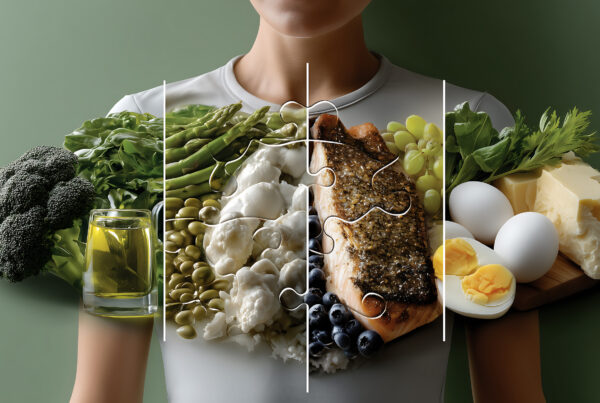”Question: After a great Thanksgiving holiday how do I reset and focus on my nutrition before Christmas?
Reading time: 5 Minutes
MWi Hack:
- Learn how to get back on track with your nutrition during the holiday season.
MWi Summary:
- One overindulgent meal does not mean you have to completely abandon your previous nutrition plan.
- These six tips can help you feel less tired and bloated after a big holiday meal:
- Get back to your normal eating schedule. Avoid skipping meals.
- Reconfigure your portions with a focus on vegetables and lean protein.
- Get more potassium to help you relieve water retention.
- Drink more water.
- Listen to your body’s satiety signals.
- Increase physical activity.
If, despite every intention of balance and moderation you completely overindulged on Thanksgiving, don’t panic. While a gluttonous yesterday may leave you feeling sluggish and heavy today, the truth is that a handful of simple strategies can help you undo the damage and get back on track fast. Here are six tried and true steps to help you lighten up, and get those uncomfortably tight jeans feeling loose again.
Step 1: Get back to your normal eating schedule
I know you may be tempted to just not eat, but skipping meals only forces your body to shift into conservation mode and burn fewer calories. Skipping can also make you more likely to hang onto any fat you’ve gained, rather than letting it go. Steady meals, on the other hand, maximize metabolism, and help regulate blood sugar and insulin levels, as well as hunger hormones. Try to eat breakfast within an hour of waking up, and eat your remaining meals three to five hours apart. Also, consider selecting a day’s worth of clean go-to meals to repeat for a few days. Your body loves consistency, so after it’s been thrown out of whack, repetition and regularity can go a long way in restoring balance.
Step 2: Reconfigure your proportions
Rather than drastically cutting calories, make non-starchy vegetables the focus of your meals, paired with lean protein, a bit of good-for-you fat, and small portions of healthy, slow-burning starch. One of the reasons you feel heavy after overeating is because your body stockpiles carbs in a form called glycogen, along with water. Cutting back, but not cutting carbs out completely, can help you level your energy and hunger (so you won’t pig out on Thanksgiving leftovers at night), while still allowing your body to let go of surplus starch. Aim for just a third to a half cup of whole food carbs in each meal, such as whole grains, and starchy vegetables.
Step 3: Get more potassium
On top of helping nerves and muscles function properly and regulating blood pressure and your body’s pH level, potassium acts as a natural diuretic. Eating more helps you de-bloat and feel lighter by sweeping excess sodium out of your body and relieving water retention. Good sources include lima beans, spinach, Brussels sprouts, sweet potato, tomatoes, avocado, lima beans, salmon, and mushrooms.
Here’s a day’s worth of meals that combine steps 2 and 3:
Breakfast
An omelet made with one whole organic egg and three whites, plus a third of a cup of each: baby spinach leaves, chopped mushrooms, sliced grape tomatoes, and cooked quinoa. Season it with a handful of fresh cilantro, and once it’s ready, top it with a quarter of a ripe avocado, sliced. (For a vegan version, you can swap eggs for mashed chickpeas.)
Lunch
A tablespoon each of balsamic vinegar and extra virgin olive oil, whisked together with a little fresh squeezed lemon and dried Italian herb seasoning, tossed with a cup and a half of torn romaine, a quarter cup each minced red onion, and chopped red bell pepper, topped with a half cup of lima beans and a third cup of cooked, chilled wild rice.
Dinner
One cup each baby Brussels sprouts and white button mushrooms, oven-roasted, paired with three ounces of broiled salmon, and a half cup of mashed baked sweet potato, seasoned with a tablespoon of extra virgin coconut oil and a dash of pumpkin pie spice (for a vegan version trade salmon for lentils)
Step 4: Drink water only, and sip more of it
Make water your only beverage and up your intake. H2O supports optimal metabolism and helps naturally curb appetite. Drinking more water also flushes out excess sodium to help you quickly de-bloat, and it gets your digestive system moving to relieve constipation. Aim for 2-2.5 liters of water a day (about 8-10 cups).
Step 5: Tune in
Eat slowly, pay attention to your body’s signals, and stop when full, even if you haven’t finished your meal. Eating at a slower pace can automatically help you curb your portions while feeling more satisfied. When you chew carefully, set your fork down between bites, and tune into your body’s signals, you’ll be able to detect your tipping point — that feeling of just right fullness. One study found that this process was just as effective for weight loss as a formal class.
Step 6: Up your activity
One way to feel lighter quickly is to torch glycogen, the carbs your body stockpiles when you’ve eaten more starch than usual. To burn it up, get your muscles moving and your heart rate up, through anything from brisk walks to a Zumba class. And remember that small boosts in your activity level add up to help, including taking stairs, or dancing in your living room!
MWi would like to thank Cynthia Sassfor sharing her expert insights with our community. Read the original article:
https://www.health.com/nutrition/6-steps-to-reset-your-diet-after-thanksgiving






